

George Aden Ahgupuk was born in 1911 in the village of Shishmaref, on the Bering Sea coast of the Seward Peninsula. His native name was Twok.
Ahgupuk attended the government school in Noorvik when he was a child, but he only completed the fourth grade. Even then he preferred to draw pictures rather than study. As a youth, he participated in the annual reindeer roundups and hunted seal and walrus for food.
ca. 1955-1961
Ink and ink wash on seal skin
15.5 x 10.3 cm
CAS 0370-1000
ca. 1950-1955
Ink on reindeer skin
35.0 x 27.3 cm
CAS 2001-0003-0002
In 1930, his uncle took him to the nearest dentist in Nome. They traveled the more than 100 miles by dogsled. On the return trip, Ahgupuk was hunting ptarmigan (grouse) when he slipped down a cliff face and fractured his leg. He and his uncle set the bone as best they could and continued homeward. Although his leg healed, the bone did not mend properly and continued to bother Ahgupuk. With no doctors or nurses nearby, however, the leg went untreated for four years.
In 1934, a field nurse with the Office of Indian Affairs insisted Ahgupuk visit the Indian Service hospital at Kotzebue. His leg injury had developed into a tubercular infection of the bone. When the doctor recommended amputating the leg, Ahgupuk begged him to try to save it. Eventually, the leg was successfully operated on and saved, but Ahgupuk remained in the hospital many months.
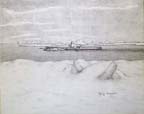 |
Untitled ca. 1950s Pen and ink on reindeer skin 25.3 x 20.2 cm CAS 1995-0009-0001 |
To pass the time during the long recovery, he began drawing scenes of everyday life and of animals and the landscape. Paper and pencils were very scarce, so he used the burnt tips of matches and drew on toilet tissue. Nan Gallagher, one of his nurses, saw his sketches and promised to bring him paper and pencils. She asked him to draw a number of scenes to send as Christmas cards. Several others on the hospital staff also commissioned cards, and when he finally left the hospital, the young artist had earned about $10.
Upon returning home to Shishmaref, Ahgupuk was again faced with the scarcity of paper. He asked his mother for some seal skins and from then onward, tanned seal skins as well as reindeer, caribou, and moose hides served as his canvases. Through trial and error, he perfected a tanning process that yielded thin, perfectly smooth, and rigid skins. The process requires repeatedly scraping, freezing, and bleaching a hide many times over a period of weeks and sometimes months. Throughout his career, Ahgupuk hunted most of the animals whose hides he needed for canvases.
Ahgupuk's early pen and ink drawings on skins often measure 24 inches by 36 inches or larger. These epic panoramas might include all of the following: an entire village scene, a reindeer roundup, men in kayaks hunting seals or polar bears, women ice fishing, a dogsled team, a blanket toss, and even a map of Alaska. Narrow strips of red alder-dyed reindeer skin are often threaded along the edges to form ribbon-like borders. On others, multiple strips of the dyed skin subdivide a larger skin into 9 smaller panels.
Untitled
ca. 1950
Pen and ink on seal skin
30.0 x 25.0 cm
CAS 0005-0069
In 1936, American artist Rockwell Kent purchased some of Ahgupuk's drawings while on a trip to Alaska. Although the two artists had not personally met, upon returning to New York, Kent wrote about his adventures and proclaimed his "discovery of the greatest of Eskimo artists." Time Magazine and The New York Times each featured articles about Ahgupuk in January, 1937, and included one of two drawings that Kent had collected. Kent was instrumental in Ahgupuk's induction into the American Artists Group, which later exhibited some of his work and also issued a series of Christmas cards that reproduced his drawings. Examples of some of these cards are at the Smithsonian Archives of American Art in Washington, DC.
|
Untitled
ca. 1960 Watercolor on caribou skin 25.1 x 10.4 cm CAS 2001-0001-0003 |
In 1950, Ahgupuk traveled to Gallup, New Mexico where he submitted several drawings for competition at the Intertribal Indian Ceremonial. A large drawing showing a map of Alaska surrounded by various people and animals was awarded the Grand Prize. Several years later, the Rosicrucian Museum in San Jose, California hosted an exhibit of his works. For many years he displayed his work at the annual Fairbanks Carnival.
 |
 |
|
Untitled
ca. 1955-1961 Ink and ink wash on reindeer skin 15.5 x 10.3 cm CAS 0370-0998 |
Untitled
ca. 1955-1961 Ink and ink wash on seal skin 15.5 x 10.3 cm CAS 0370-0999 |
Over the years, Ahgupuk experimented with various media and materials. Early in his career, he completed a handful of ivory carvings. He did not enjoy that medium however, especially the dust it created, and decided to concentrate on pen and ink drawings. As was typical of other native artists working in the 1930 to 1960 era, Ahgupuk produced drawings on a variety of objects and materials in an attempt to expand the market for his work. He made small coin purses or wallets of tanned skins with drawings on both the front and back. Larger skin "canvases" with two drawings done alongside each other were folded around a book to form a book cover. The artist has also completed a number of oil paintings. Some of his pen and ink drawings have been enhanced with watercolors, particularly to highlight the white snow and ice formations that he often depicted. In addition to the skins and hides of the animals already mentioned, salmon skins also were used, albeit rarely, as canvases, producing a textural effect in the finished work.
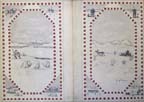 |
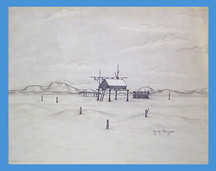 |
|
Book
cover
ca. 1940s-1950s Pen and ink on reindeer skin with strips of dyed deer skin 33.2 x 23.0 cm CAS 1995-0009-0002 |
Untitled
ca. 1950-1955 Ink on reindeer skin 34.7 x 27.3 cm CAS 2001-0003-0001 |
During the 1950s, Ahgupuk experimented by doing a limited number of drawings directly on glazed ceramic wall tiles. 3 inch by 3 inch tiles were used for black and white drawings, while colored drawings were done on larger 5 inch by 5 inch tiles. On at least one extant example, the painted image is beginning to flake off, because no attempt was made to "fix" the image to the tile surface. It is likely that other examples are similarly deteriorated, as a few are known to still exist in private collections.
In 1953, The Deers Press in Seattle published a portfolio of eighteen drawings, entitled 18 Reproductions of Paintings by Alaska's Most Distinguished Artist George Ahgupuk. The series illustrates Alaskan history from the artist's perspective, beginning with traditional hunting scenes to the building of large office buildings in Alaska's major cities. Ahgupuk has also illustrated several books. Edward Keithahn, a teacher at Shishmaref, collected a number of Eskimo stories from local school children in the 1940s. He then commissioned Ahgupuk to illustrate the stories, published in 1953 as Igloo Tales, and republished in 1958 as Alaskan Igloo Tales. In 1959, the artist illustrated I Am Eskimo - Aknik my name, a semi-autobiographical collection of stories by Paul Green and Abbe Abbott. A number of his drawings also appear in Alaska: The Big Land and The Last Frontier, a Short History of Alaska, both by Ben Adams.
 |
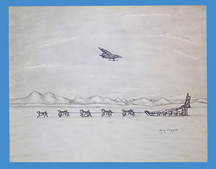 |
|
Untitled
ca. 1955-1961 Ink and ink wash on reindeer skin 15.5 x 10.3 cm CAS 0370-1001 |
Untitled
ca. 1950-1955 Ink on reindeer skin 34.9 x 27.4 cm CAS 2001-0003-0003 |
On a more commercial scale, during the 1950s a curio shop in Anchorage marketed small table and wall lamps as souvenirs of Alaska. The ceramic bases were in the form of billikens, antlers, and undecorated geometric shapes. The shades for these lamps were made of three or more parchment-like panels, stitched together with man-made laces that were probably intended to look like baleen. Each panel on a lamp shade was imprinted with a different Ahgupuk drawing. Drawings were also reproduced on a series of plastic placemats, small wooden wall plaques, and ceramic plates.
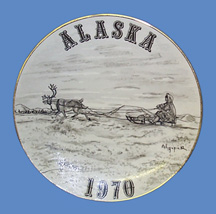
Ceramic plate
ca.
1970
diameter: 21.8 cm
CAS 2001-0001-0004
In 1978, Ahgupuk was one of six Native Alaskan artists whose works were selected for the new Anchorage Sheraton Hotel. The Italian sculptor, Neromi, was commissioned to interpret the works on a larger scale and render them in marble in several of the hotel's public areas. For reasons unknown, however, Ahgupuk's works were never actually used in the hotel.
 |
Untitled ca. 1955-1961 Ink and ink wash on bleached skin 25.3 x 10.5 cm CAS 0370-1002 |
In addition to the examples in the collection of the California Academy of Sciences, major holdings of Ahgupuk's work are in the collections of the University of Alaska Museum, Fairbanks and the Anchorage Museum of History and Art. The Alaska State Museum at Juneau, the Seattle Museum of History and Industry (Seattle, WA), the Riverside Municipal Museum (Riverside, CA), the National Museum of the American Indian, Smithsonian Institution (Washington, DC), and the National Cowboy and Western Heritage Museum (Oklahoma City, OK) also have works by him. Ahgupuk probably produced several thousand drawings and paintings during his career, many of which are in private collections.
Ahgupuk's ability to paint and draw was greatly curtailed during the 1990s as a result of his declining health. A stack of prepared skin canvases in his studio was a testament to his will to continue documenting an earlier lifestyle that most younger native Alaskans have only heard about from their grandparents or read about in books. George Ahgupuk died on April 1, 2001.
|
|
|
![]()
George Aden Ahgupuk Reading List
Adams, Ben
Alaska: The Big Land. New York: Hill and Wang, 1959.
The Last Frontier, a Short History of Alaska. New York: Hill and Wang, 1961.
Ahgupuk, George A.
18 Reproductions of Paintings by Alaska's Most Distinguished Artist George Ahgupuk. Seattle: The Deers Press, 1953.
Archuleta, Margaret and Rennard Strickland
Shared Visions: Native American Painters and Sculptors in the Twentieth Century. New York: The New Press, 1991.
Frederick, Saradell Ard
"Alaskan Eskimo Art Today." The Alaska Journal, Vol. 2, No. 4, 1972, pp. 30-41.
Frost, Helen
Frost Among the Eskimos: The Memoirs of Helen Frost, Missionary Nurse on the Seward Peninsula, 1926-1961. Concord, CA: Lutheran Pioneer Press, 2001, pp. ii-vi, ix, 163-164.
Green, Paul
I Am Eskimo: Aknik My Name. Juneau: Northwest Publishing Co., 1959.
Hartman, Russell P.
"George Aden Ahgupuk, Inupiaq Eskimo Artist, 1911-2001." Eskimo Drawings. Suzi Jones, ed. Anchorage: Anchorage Museum of History and Art, 2003, pp. 85-99.
Keithahn, Edward L.
Alaskan Igloo Tales. Seattle, WA: Robert D. Seal, 1958. (Originally published as Igloo Tales, Lawrence, KS: The Haskell Press, 1953).
Merrick, Elliot
"Without Words." Scribner's Magazine, Vol. 100 (January-June) 1938, pp. 18-23.
Mozee, Yvonne
"George Ahgupuk." The Alaska Journal, Vol. 5, No. 3, 1975.
New York Times
"Kent Discovers an Eskimo Artist." January 11, 1937, p. 21.
Ray, Dorothy Jean
Graphic Arts of the Alaskan Eskimo; Native American Arts 2. Washington, DC: U. S. Dept. of the Interior, Indian Arts and Crafts Board, 1969.
Eskimo Art: Tradition and Innovation in North Alaska. Seattle: University of Washington Press, 1977.
A Legacy of Arctic Art. Seattle: University of Washington Press for the University of Alaska Museum, 1996.
Sweeney, David P.
"Memories of My Grandfather, George 'Twok' Aden Ahgupuk." Eskimo Drawings. Suzi Jones, ed. Anchorage: Anchorage Museum of History and Art, 2003, p. 101.
Time Magazine
"Twok." January 25, 1937, p. 29.
Woods, Anne
"Artist of Shishmaref." The Alaska Sportsman. Oct., 1957, pp. 16-17, 41-43.
Woodward, Kesler
Painting in the North: Alaskan Art in the Anchorage Museum of History and Art. Anchorage: Anchorage Museum of History and Art, distributed by the University of Washington Press, 1993.
Yorba, Jonathan
Drawn from the Surroundings: The Elkus Collection of Eskimo Paintings. San Francisco: A. S. Graphics, San Francisco State University, 1990.
![]()